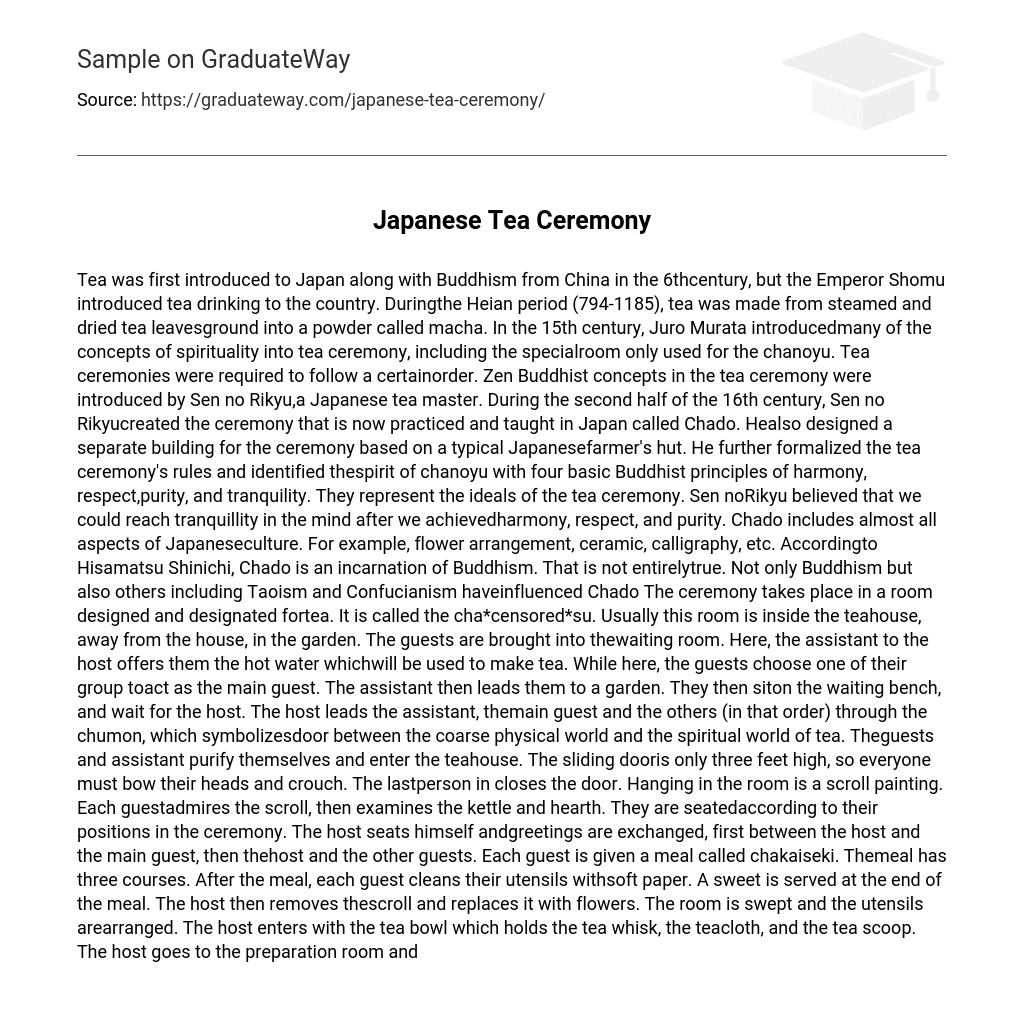Tea was first introduced to Japan along with Buddhism from China in the 6thcentury, but the Emperor Shomu introduced tea drinking to the country. Duringthe Heian period (794-1185), tea was made from steamed and dried tea leavesground into a powder called macha. In the 15th century, Juro Murata introducedmany of the concepts of spirituality into tea ceremony, including the specialroom only used for the chanoyu. Tea ceremonies were required to follow a certainorder.
Zen Buddhist concepts in the tea ceremony were introduced by Sen no Rikyu,a Japanese tea master. During the second half of the 16th century, Sen no Rikyucreated the ceremony that is now practiced and taught in Japan called Chado. Healso designed a separate building for the ceremony based on a typical Japanesefarmer’s hut. He further formalized the tea ceremony’s rules and identified thespirit of chanoyu with four basic Buddhist principles of harmony, respect,purity, and tranquility. They represent the ideals of the tea ceremony. Sen noRikyu believed that we could reach tranquillity in the mind after we achievedharmony, respect, and purity. Chado includes almost all aspects of Japaneseculture. For example, flower arrangement, ceramic, calligraphy, etc.
Accordingto Hisamatsu Shinichi, Chado is an incarnation of Buddhism. That is not entirelytrue. Not only Buddhism but also others including Taoism and Confucianism haveinfluenced Chado The ceremony takes place in a room designed and designated fortea. It is called the cha censored su. Usually this room is inside the teahouse, away from the house, in the garden.
The guests are brought into thewaiting room. Here, the assistant to the host offers them the hot water whichwill be used to make tea. While here, the guests choose one of their group toact as the main guest. The assistant then leads them to a garden. They then siton the waiting bench, and wait for the host. The host leads the assistant, themain guest and the others (in that order) through the chumon, which symbolizesdoor between the coarse physical world and the spiritual world of tea. Theguests and assistant purify themselves and enter the teahouse. The sliding dooris only three feet high, so everyone must bow their heads and crouch.
The lastperson in closes the door. Hanging in the room is a scroll painting. Each guestadmires the scroll, then examines the kettle and hearth. They are seatedaccording to their positions in the ceremony. The host seats himself andgreetings are exchanged, first between the host and the main guest, then thehost and the other guests. Each guest is given a meal called chakaiseki. Themeal has three courses. After the meal, each guest cleans their utensils withsoft paper. A sweet is served at the end of the meal.
The host then removes thescroll and replaces it with flowers. The room is swept and the utensils arearranged. The host enters with the tea bowl which holds the tea whisk, the teacloth, and the tea scoop. The host goes to the preparation room and returns withthe waste water bowl, the bamboo water ladle, and a green bamboo rest for thekettle lid. Then he closes the door to the preparation room. Using a fine silkcloth the host cleans the tea container and scoop. Hot water is put into the teabowl, the whisk is rinsed, the tea bowl is emptied and wiped with the cloth. Thehost places three scoops of tea per guest into the tea bowl. Enough hot water isput into the teabowl to create a thin paste with the whisk.
More water is thenadded. The host passes the tea bowl to the main guest who bows. The bowl israised and turned to be admired. The guest then drinks some of the tea, wipesthe rim of the bowl, and passes the bowl to the next guest who does the same asthe main guest. When the guests have all tasted the tea, the bowl is given tothe host, who rinses it. The whisk, the tea scoop, and the tea container arecleaned. At the conclusion, the guests express their appreciation for the tea,and leave while the host watches from the door of the teahouse.





